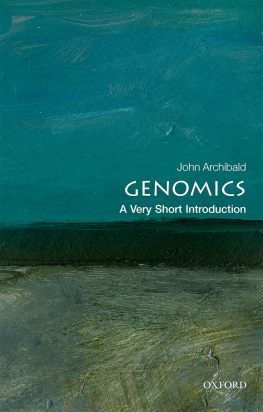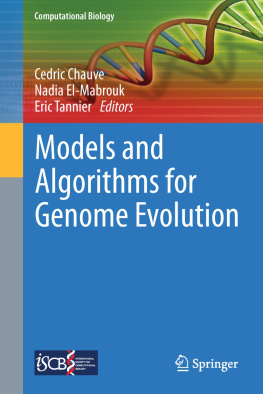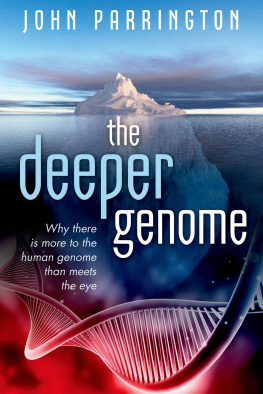Ancestors in Our Genome

Oxford University Press is a department of the University of Oxford.
It furthers the Universitys objective of excellence in research, scholarship and education by publishing worldwide.
Oxford New York
Auckland Cape Town Dar es Salaam Hong Kong Karachi
Kuala Lumpur Madrid Melbourne Mexico City Nairobi
New Delhi Shanghai Taipei Toronto
With offices in
Argentina Austria Brazil Chile Czech Republic France Greece
Guatemala Hungary Italy Japan Poland Portugal Singapore
South Korea Switzerland Thailand Turkey Ukraine Vietnam
Oxford is a registered trademark of Oxford University Press in the UK and certain other countries.
Published in the United States of America by
Oxford University Press
198 Madison Avenue, New York, NY 10016
Eugene Harris 2015
All rights reserved. No part of this publication may be reproduced, stored in a retrieval system, or transmitted, in any form or by any means, without the prior permission in writing of Oxford University Press, or as expressly permitted by law, by license, or under terms agreed with the appropriate reproduction rights organization. Inquiries concerning reproduction outside the scope of the above should be sent to the Rights Department, Oxford University Press, at the address above.
You must not circulate this work in any other form and you must impose this same condition on any acquirer.
Library of Congress Cataloging-in-Publication Data
Harris, Eugene E. (Professor), author. Ancestors in our genome : the new science of human evolution / Eugene E. Harris.
p. ; cm.
Includes bibliographical references and index.
ISBN 9780199978038 (alk. paper)
I. Title. [DNLM: 1. Genome, Human. 2. Biological Evolution. 3. Hominidaegenetics. QU 460] QP624
611.018166dc23
2014010296
eISBN 9780199978205
To my parents, Joan and Whitney, and my son, Bryan
CONTENTS
FIGURES
TABLE
I thank the following colleagues for their generous time in commenting on chapters: Drs. Gnter Bruer, Henry Harpending, Jody Hey, Carles Lalueza-Fox, Diogo Meyer, Maryellen Ruvolo, Caro-Beth Stewart, as well as two anonymous reviewers. Rebecca Ham deserves very special thanks for her extremely thorough editorial advice, organization suggestions, and encouragement. All illustrations were rendered with the expert and very gracious help of Kei Hayashi. Drs. Sarah Tishkoff, Hopi Hoekstra, Gnter Bruer, Michael Day, and John Fleagle kindly allowed me to use research photos of theirs. Tim White and David Brill allowed me to use photos of fossil skulls. Stephen Nash generously allowed me to use his original illustrations of papionin monkeys. I thank Jeremy Lewis, Erik Hane and Michael Stein at Oxford University Press for their generous editorial advice. An extra special thanks goes to my agent Deirdre Mullane for her sound editorial advice and her steadfast and generous support in guiding this project along. I also owe a debt of gratitude to my previous mentors Terry Harrison, Clifford Jolly, Todd Disotell and Jody Hey. I also thank Dean Falk for her helpful advice and support, Lisa Schlotterhausen for her editorial suggestions, as well as my colleagues Avelin Malyango, Varsha Pilbrow, and Scott Sherman. Any inaccuracies or mistakes in interpretation of other peoples work are my own.
We are now in an era of enormous potential for studies of our evolutionary past. With the determination of the full human genome sequence in 2001the culmination of a scientific quest begun almost fifty years earlier when James Watson and Francis Crick first discovered the molecular structure of DNAwe are at the beginning of a genomic voyage back in time. The pace at which full genomes of our primate relatives are also being sequenced is exhilarating; genomes of the common chimpanzee, bonobo, gorilla, orangutan, and macaque monkey have already been fully determined and that of other primates is well under way. Armed with sophisticated new tools, researchers are starting to examine variations in our genome among diverse peoples of the world and compare it with those of our close primate relatives in order to answer age-old questions about where, when, and how we evolved. For the first time, we are seeing our ancestors in our genome, obtaining new and often astonishing views of our evolutionary past, and we are already beginning to identify genomic features in which humans are similar to other primates and features in which humans are unique. Numerous large-scale studies have also started to catalogue millions of differences in DNA among individuals from around the world, providing us with more finely detailed knowledge of genetic diversity within our own species. Among other remarkable insights, genomic analyses are enabling us to identify with great certainty evolutionary relationships among our ape cousins; to estimate more precisely the time and nature of the evolutionary process that produced the human lineage; to identify the genetic bases of our species adaptations, such as increased brain size and language; and to determine when and by which genetic mechanisms human populations adapted to different environments around the world. In short, the unprecedented scale of genomic evidence now being collected is revolutionizing how and what we can learn about our origins.
The source of all this information is found in the nucleotides of the human genome, the strands of molecules that join together in varying but precise ways to form the ladderlike steps of hereditary information encoded in the helical structure of our DNA. Although each persons genome is unique, reflecting the individual biological blueprints we inherit from our parents, the basic structure of the genome is similar across our species. (This is the reason why some scientists refer to the human genome, even though this is not technically accurate.) The entire human genome is somewhat greater than three billion nucleotides in length, organized into segments that combine to form genes that code for the proteins in the human body and influence the development of our every physical feature, from eye color to blood type. Like pearls strung along a DNA necklace, genes can be of different lengths, ranging from a few hundred nucleotides for the smallest genes to a few million nucleotides for the longest.
A genes A, C, G, and T nucleotides provide the instructions to our body about how to construct its different proteins. Proteins, of course, are macromolecules that play innumerable important functions and are the workhorses of our bodies. A protein like collagen plays a structural role in making our bones, ligaments, and tendons strong; the protein hemoglobin in our red blood cells helps transport oxygen and carbon dioxide in and out of our tissues; and the protein fibrin is essential for normal blood clotting. Proteins themselves are actually composed of chains of little building block molecules called amino acidsof which we have twenty different typesand each different protein has a unique chain of these amino acids. The type and order of DNA nucleotides in a gene provides the instructions on how to put these amino acids together.
Perhaps surprisingly, however, genes make up only about 1.5% percent of the entire human genome. This means that only a very small fraction of our vast genome is actually coding for the proteins that carry out important structural and functional roles that make our body work. The remainder of the genome was long considered to be almost entirely junk DNA (i.e. non-functional), but more recent studies have estimated that as much as 4% to 12% of this remaining DNA also has important functions and perhaps plays important roles in controlling the expression of genes. For example, many short elements within the genome have been identified that can turn genes on and off, or can increase and decrease the amounts of protein genes produce. These gene switches are responsible for activating different sets of genes in different anatomical regions of our body, which helps to explain why our brains have very different characteristics from our livers.







